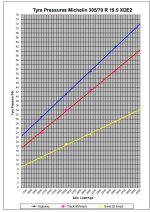Oh of course they do! But for something like hauling a truck camper, I'm a lot more concerned with cost and function than "does it look cool." I'm also not someone who finds "having a bad** looking truck" appealing (just not my vibe).
I agree! I'm here asking questions, right?
For sure, and thanks for all of the additional info!
I don't see this is a linear process. Understanding the tradeoffs of 350/3500 trucks vs. 550/5500 trucks, DRW vs. super singles, and so on all help inform the design decisions.
As an example, I'd LIKE to be able to do some beach camping.
There are a few ways we could get there...
That's not the ONLY criteria, of course. There's no perfect setup, it's all about compromises.
- Lighter camper running on an SRW 350/3500.
- Bigger truck converted to super singles that can be aired down.
- Maybe a smaller DRW with tires that can be aired down a little?
My point is that it's easy to say "figure out what you want to do, then pick the truck," but understanding what those tradeoffs are is part of the process (for me, anyways). Which is, again, why I'm here asking questions.
I get your point about truck appearance - I am not a "truck guy" myself, either. But 41" MPTs do look cool lol. Cost is a real concern for most of us and as a consequence, it would seem like the most direct path would be to start with DRW and if you're unable to get to the places you want as a result, consider super singles (and the other associated costs) then.
I agree that it isn't a linear "if this, then that" approach. As an observer of your path, it just seems like you're in the analysis-paralysis portion of your journey. At some point, decisions have to be made and compromises have to be accepted. Good luck.


